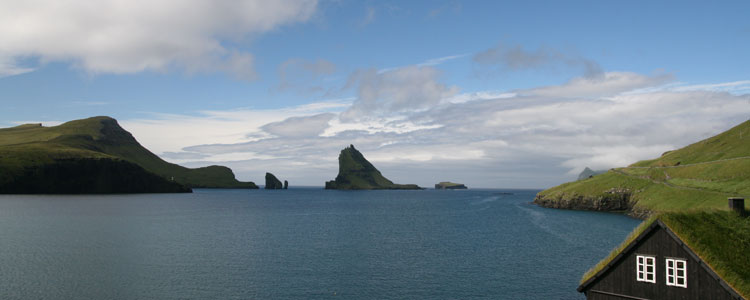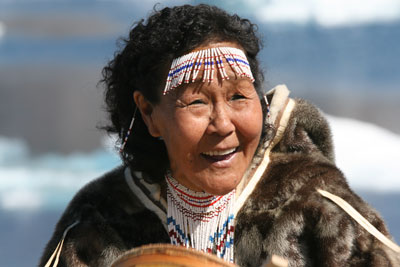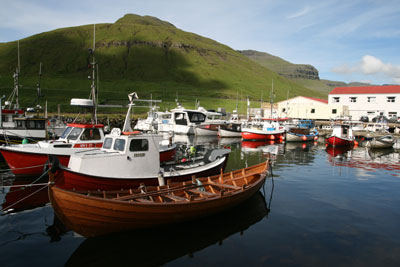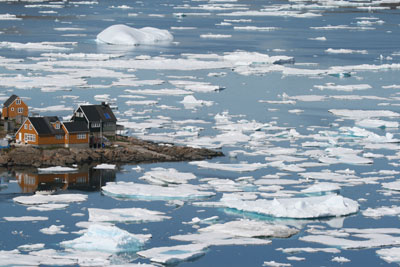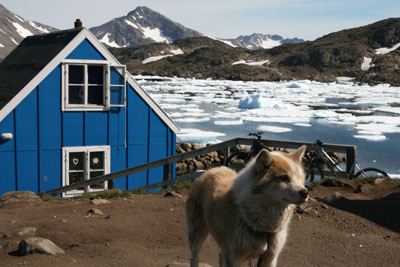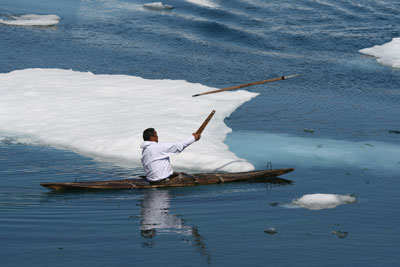The Faroe Islands plus day-tripping in Greenland
by Bill Reed, Denton, TX
After our time in Iceland (April ’11, pg. 6), my wife, Betty, and I continued our 16-day journey with a flight from Reykjavík to the Faroe Islands on Atlantic Airways. They, apparently, have not learned how to charge their passengers for an aisle seat, extra bags or a drink or even for boarding with the first group.
The flight was a short hour and 15 minutes, and about 20 minutes into the flight they came around with a sandwich big enough for a meal, followed by a drink, for each of us. I saw that they had beer, wine and other beverages and asked how much they cost. The flight attendant looked at me a little funny and said, “Nothing! Everything is free here.” I love these guys!
The Faroe Islands
The Faroe Islands will take your breath away. Why only about 200 Americans a year go there, I don’t know, but that’s the figure I was told by an airport employee.
There are about 48,000 people residing on the islands. The average town size is counted in tens of houses; a few hundred houses is a large town.
There are no attractions in the sense of tourist attractions; you go to the Faroe Islands to see their beauty. You don’t go for the nightlife, the museums or fine dining. You go for the scenery.
As part of our package with Nordic Visitor (Laugavegur 26, 101 Reykjavík; phone 354 578 20 80), we had arranged for a rental car at the airport.
When I picked up the car, I was given a little round “pass” that I was to press against the button on the airport’s entrance/exit gate. Unfortunately, I didn’t realize you had to actually press it against the button, since I was told, “Just put it in front of the entrance gate,” which, in my mind, meant “pretty close.” They are a friendly people, however, and soon somebody came to help.
The first night, we stayed in the 62°N Airport Hotel in Sørvágur. This hotel is about as Spartan as one can get. There is a place to eat and a small bar, where you will probably be the only patron, plus rooms, but it provided all the basics we needed.
The next day we drove to Tórshavn, the largest city in the Faroe Islands. It is home to about 19,000 people, or a little more than one-third of the population.
We stayed at Hotel Tórshavn, which was a short block’s walk from the waterfront, with good views of the harbor. Wandering down to the harbor, we had drinks at the local pub, which was, literally, on the sidewalk — there was no “inside.”
A short drive from Tórshavn is Kirkjubøur, which consists of about 20 houses and the obligatory harbor. Of particular note is the house named Roykstovan. The family has lived in this house for the last 900 years.
Visitors can tour some of the house, the rooms of which are furnished with items dating back a number of years. It was a nice gesture from the family to allow us into a part of their home.
Most of the houses in the area are roofed with sod, with exterior walls covered in black tar. Red trim accents the windows, doors and the roofs’ edges. The red-trimmed black houses contrast beautifully with the brilliant green hillsides flecked with white sheep.
Wet and green
The Faroe Islands sit in the middle of the Gulf Stream, which keeps the water temperature at around 41°-43°F year-round. These constant water temperatures keep the islands at a very moderate, cool temperature, although they are on roughly the same latitude as Anchorage, Alaska. On average, it freezes only four times a year.
On the other hand, the temperature never got above about 50°F all the time we were there. It is a cool, damp place.
As with Iceland, you have to understand that it’s going to rain a lot. When it was clear, the sky was a vibrant blue and the hills were a green that is hard to describe, with hundreds of little streams gleaming in the sun. In the sun, this place is spectacular (but it’s still beautiful when it’s overcast).
Later that day we walked to the old part of town and right up to a door that said “Prime Minister’s Office. Open 8:00 a.m.” I suppose, had it been open, I might have been able to meet him. Can you imagine getting that close to a country’s prime minister?
The next day we took a ferry to the island of Sandoy, where our car quickly became the only one on the road. As with the other islands, you go for the scenery — which we got to see all by ourselves, as we seemed to be the only people there. For us, that was a plus. We walked on the beaches, crossing the stones to poke around in a little stream.
Later we did meet another car. It was on a one-lane road, so we had to stop, but a man got out, came over and asked, “Are you the Reeds?” Now, there were probably only a dozen cars on the whole island, yet we had run into somebody who knew who we were. As it turned out, we had been scheduled to go on a tour with him and he was looking for us. He found us.
A light rain followed us all day, and I kept my camera under a shopping bag to keep it dry, taking it out only long enough to take a picture. Our rain coats and pants came in handy that day.
The next day we drove to Vestmanna, where we caught a boat to the Vestmanna Cliffs. We were extremely lucky because the day was completely clear.
We had hoped to see puffins, but, being hungry little birds, they were not nesting there that year because their food source was too far from land. This did not, however, diminish the trip.
Our boat headed out alongside the massive hills that drop precipitously to the water. They are so steep that only the sheep can navigate them.
The base of the cliffs was pockmarked with caves — some large enough for us to motor into, some not. This is one boat trip we could take over and over just because the scenery was so spectacular.
Contrasts in atmosphere
The concept of time is different in the Faroe Islands. During our July ’10 visit, the sun set sometime around midnight, though it never really got dark, so the idea of getting to some location “before dark” had no meaning. With that in mind, we headed up a winding road through the mountains toward that night’s lodging, Hotel Gjaargarour in Gjógv.
The picturesque town sits next to a very protected, very small natural harbor that is still in use. The town has partially blocked the river to create a bathing spot, though we didn’t see anybody in the water, as it was only 40 degrees outside and the water could not have been much warmer. We did see kids paddling around the small pond in rubber boats. The scene was one of complete peace and safety. This is how kids should play.
The next day we drove to Klaksvík. Our hotel in Klaksvík was as described in one of the travel books Betty had brought along: Stalinesque. I had no idea what that meant before we arrived, but now I do.
The hotel was nondescript on the outside — a big, white box with windows. There was a sign on the front door that said “Tourists Welcome.” I had to wonder, ‘Who normally stays in this hotel? Businesspeople, traveling salesmen, the odd husband who has been locked out of his house for the night?’ Apparently, tourists were an unusual thing in this hotel, which, by the way, was the only one in town.
The inside was more plain than the outside. Strangely, each room had two entry doors. The first door, facing the drab hall, was painted a brick red as all the hallway doors were painted. The place reminded me of some sort of detention hall where all the monitor had to do was glance down the hall to see that all the captives were in their rooms.
About six inches beyond the red door was another, wooden door that led into our room. Once we had passed the second door, we found a room that was acceptable though a little drab by most standards. They had just completed an upgrade to the place, so I had to wonder what it was like before.
We asked for a room that looked out over the harbor and got one with a nice view.
That evening we went to the Restaurant Hereford (Klaksvíksvegur 45), which was a good place to eat. The food came on designer plates about the size of a small washboard and was strategically arranged to show it off to the best effect. It was like eating a piece of art, though we had nothing special (steak and fries with vegetables). With beer and wine, the meal cost $70 to $80.
As in Iceland, meals were about twice the price you would expect to pay in the US. Just accept it. It will make life easier.
On to Greenland
We spent our last night in the airport hotel in Sørvágur, where we had started, before boarding the flight back to Reykjavík for one more night in Hotel Fron. From there we took a one-day hop to Greenland. This flight turned out to be the highlight of our trip.
Our plane climbed from the runway into the clouds, which accompanied us all the way to Greenland. As we approached the coastline, the clouds parted and we could see the blue ocean covered with small icebergs, ranging from small, flat sea ice to large glacial bergs. The islands were completely bare — just huge, round mounds of solid rock.
I don’t know if our flight was different or the clarity of the day inspired the extra time in the air, but the pilot took us on a tour of the southern tip of the island, winding through the mountains so there were times when we had to look up to see the tops. It was a magical flight.
We landed on a little dirt airstrip, where we met our guide, his wife and their young son. An anthropology professor in Iceland, he runs tours and a little shop in Greenland during the summer.
The walk to the town of Kulusuk was about a mile. The sun was intense and we soon took off our jackets. As we crested a hill, we saw the little town of Kulusuk revealed — an image of sharp, crisp lines. The ice floating in the bay contrasted with the blue water, which came to an abrupt end at the shoreline. Blue, red and yellow houses stood out against this backdrop. A photographer’s paradise!
The villagers get a stipend of some sort from the Danish government, and there appeared to be little to do there during the day. Food can be purchased in a small grocery store, and seals are hunted in the bay. Seal meat is used to feed the sled dogs that are tied up throughout the town. All this might sound depressing, but it wasn’t. This is the way they live, and I felt privileged to have peeked into it for a few hours.
For the most part, the villagers ignored us and just watched as we walked by. We were a curiosity as much as anything.
This day trip was expensive (about $500 each) but well worth it.
Wrapping up
I’m not sure why more Americans don’t go to Iceland and the Faroe Islands. If you want an easy trip, you will find it in Iceland but not so much in the Faroe Islands, though that is part of the beauty of this sort of trip. In the bargain, you will get stunning beauty and sights you cannot see anywhere else in the world.
If you are traveling to Scandinavia from the US, you will fly right over both places. Stop, if only for a few days, and see what each has to offer. For us, they provided exactly the type of vacation we like. We want to get cold, wet and tired, and we were able to do all these things.
This has turned out to be one trip we think about a lot.

